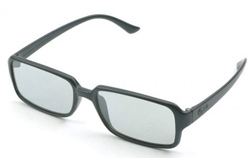Europe's online source of news, data & analysis for professionals involved in packaged media and new delivery technologies

'Passive' LG vs 'active' Samsung - the 3D TV tech competition hots up
The passive 3D TV technology may have the edge on the competing active shutter glasses 3D option if one goes by a consumer study funded by LG – that happens to push the passive approach – but NPD data reveal that it is Samsung, active 3D technology cheerleader, that has a commanding share of the 3D TV market.
Wanting to find out which technology consumers liked best, LG commissioned research outfit Morpace to do the study. They measured real-time feedback and found that consumers preferred 3D passive technology in a variety of categories, including overall 3D experience, 3D picture quality and 3D effect. Some 78% said that they prefer the LG Cinema 3D glasses, which are similar to the lighter 3D glasses used in 3D theatre, over the active shutter glasses for 3DTV from Sony and Samsung.
When it comes to market domination, however, Samsung is the horse to beat. The Korean maker announced that it has surpassed the 60% market share threshold to establish a commanding lead in the US 3D TV market, according to newly released revenue and unit sell-through data from market research company The NPD Group.
Specifically, for the time period 22 May-18 June, Samsung has a unit and dollar share of 61% in the 3D TV market, which includes both LED and Plasma 3D TVs. In addition, according to NPD’s Retail Tracking Service, Samsung has over 50% unit and dollar market share for April to May.
“Clearly consumers are voting with their wallets and choosing the TV that provides a superior 3D experience,” said John Revie, senior vice president of Home Entertainment, Samsung Electronics America.
Whereas proponents of active shutter 3D glasses say their technology delivers full HD 1080p picture for each eye, a wider viewing angle and no black lines interfering with the picture, proponents of passive 3D technology claim a brighter image, less flicker and little to no crosstalk as advantages.
The Consumer Electronics Association says that by 2014, 3DTVs will account for over 40 percent of the overall TV sales. For its part, research from IHS iSuppli forecasts that by 2015, more than half of those 3DTVs will be passive 3D models.
Sales of 3D TV sets are expected to slow this year, with only 1.8 million or about 2 per cent of all US TV homes owning a 3D set by the end of 2011, according to a new report from SNL Kagan, which is also predicting that growth will return in 2012 and beyond, as 3D set penetration grows from about 5 per cent in 2012 to 21 per cent in 2015.
Story filed 04.07.11



















